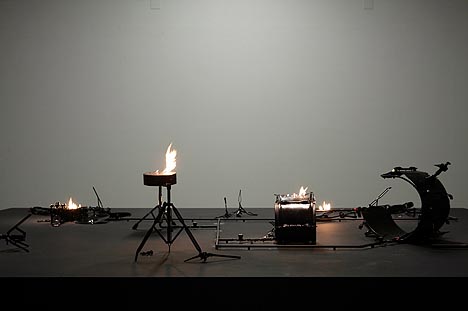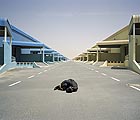
translated and summarized by: Liz Wollner-Grandville,
English summary April 14 - 19
Kunsthalle Wien: Elevator to the scaffold – Banks Violette & Miles Davis, Dashiell Hammett, John Huston, Weegee
At the scene of crime
A list of participants of an exhibition mainly consisting of names not attributed to fine arts makes one curious about what’s coming up. The Kunsthalle, now presenting “Elevator to the scaffold – Banks Violette & Miles Davis, Dashiell Hammett, John Huston, Weegee”, has successfully done this once before: with the Bruce Naumann/Samuel Beckett exhibition.
The topic setting is inspiring: scenes of crime, an attitude of refusal towards any morale. The curators Banks Violette and Gerald Matt, director of the Kunsthalle, attempt to pursue the gray area between lying and truth. Violette positions a burning drum set on the podium and combines it with a mirrored wall, which is destroyed by monstrous apparatus step by step during the exhibition. Violette’s heavy-metal fire resembles a scene of violent action – however, the action is already a thing of the past. A fact that is shared with film clippings of John Huston’s “Maltese Falcon”, in which Humphrey Bogart trudged through houses that were about to be torn down, and the reconstruction of the fascinating crime scenes by Weegee: with plywood boards attracting attention with blatant messages such as “murder”, “more murder”, “tragedy”, or “odds and ends”. Here the act is also a thing of the past, the corpses are in the gutter, and police take care of the official dealings.
As so often, the inadequacy of the medium does the exhibition no good: the first edition of Hammett’s novel is presented under a glass cover – leaving no insight at all. Miles Davis’ music is heard from an extra room – an obvious compromise. And John Huston’s “Maltese Falcon” is shown on computer terminals – rather trashy. Similar to the exhibition currently presented one floor lower (“The Porn Identity”) one tends to wonder why, at times, art so rarely relies on itself.
By Nina Schedlmayer
Kunsthalle Wien
1070 Vienna, Museumsplatz 1, until 03.05.09
www.kunsthallewien.at
Galerie Grita Insam: Peter Weibel – On modern finance architecture and inhabitable libraries
The polyartist as a political artist
Oftentimes, when one undertakes the most obvious and natural, bizarre facets emerge. One can, for example, simply regard the world literally. Progenitor of all this is Diogenes who, after Alexander the Great accused him of behaving like a dog, peed against his leg.
One can, if your name is Baselitz, turn things upside down. And if one is world famous as Peter Weibel one constructs an installation titled “Zur modernen Finanzarchitektur” (on modern finance architecture), which embodies a shack, a Favela, comprised of dumped objects, ranging from old files to a glossy Yves Saint Laurent box. Add a heap of newspapers under a Plexiglas stand, position a black pyramid next to it, and name the arrangement “In the shadow of the silent majority”. Or take a photo of a stock chart, trace the curve with white powder, resembling cocaine, and call the whole thing “Line of Crime”.
With his current exhibition at Grita Insam’s gallery Peter Weibel, similar to his works from the 1960s and 70s, he never seems to be at a loss for an answer. Weibel’s style is violent, platitudinous, and straightforward. But what could be more violent and platitudinous than the circumstances he satirizes. Weibel brings “Context Art”, propagated by him at the beginning of the 90’s, to the boil - and reacted immediately, unreasonably, and invincibly. What is presented here is no caricature. It is pure reality.
More pensive works are presented in the gallery’s second exhibition space. Weibel decided to make Karlsruhe, where he heads the Center for Art and Media (ZKM), to his domicile and transferred his thousands of books there. The minimal amount of living space that remained, brought him to think about architecture, respectively he let students of the Academy of Applied Arts think about the topic. This makes Weibel well nigh poetic. Otherwise he is direct, concrete; here the polyartist is a political artist. This does no harm these days.
By Rainer Metzger
Galerie Grita Insam
1010 Vienna, an der Hülben 3, until 25.04.09
www.galeriegritainsam.at
NGBK Neue Gesellschaft für Bildende Kunst, Kunstraum Kreuzberg: Islands + Ghettos. On the territorial segregation of cities in the 21st century
Think outside the box
A few days ago it was announced that Heidelberg would receive the ADKV Art Cologne Prize for art associations ; the award winning works are currently displayed in Berlin. The project of the Heidelberg Kunstverein “Islands + Ghettos” has been taken on by numerous institutions. The awkward title might be deterring, but it holds more than it promises: not a hermetically super-intellectualized theoretical depiction, but individual artistic positions, which complement each other. They deal with the phenomenon of an increasing spatial polarisation - observed in many cities, and with their geopolitical and socio economical coherences.
Numerous cartographic illustrations, architectural models or photographic city views are displayed. Brothels, call-centers or autopsy centers are marked on a map by the van Lieshout studio in their work “Slave City – Urban Plan” (2005). In “Crossing Gates” (2008) Michael Zinangel & Michael Hieslmair combine soundtracks, on which you hear the daily transgressions within an urban as well as a socio-cultural framework, with fragments of models of different cities. The photographs of Luis Molina-Pantin stage the - at times - grotesque excesses of architecture in Cali and Bogotá. In her series “Body Techniques” Carey Young approaches the contrasting city setting of Dubai with her own body.
The constantly expanding cities Dubai and Caracas are the central theme of the exhibition, which – in view of the current financial crisis – offers an enlightening if not exemplifying comment. Stuart Elster’s “Colossus” (2007) depicta money, and thereby illustrates its symbolic value as well as the implied exclusion mechanisms. Sabine Bitter and Helmut Weber’s video work “Living Megastructures” (2003 – 2004) is devoted to the mass apartment blocks in the Barrios of Caracas. Dorit Margreiter and Annette Baldauf’s “The She Zone” show a shopping mall in Abu Dhabi, which is exclusively accessible to women, and Harun Farocki’s analysis of “non-locations” (“The creator of shopping worlds”, 2001) seems absurd and odd, maybe because he focuses on Austrian and German conditions.
Javier Téllez’s “One flew over the Void (Balla Perdida)” (2005) abrogates solid structures with a special kind humour: a procession of mentally ill at the Mexican-American border are confronted with a human canon – an American citizen – flying over the border fencing. Peter Coffin goes one step further: in “Micronations” (2009) he assembles objects such as stamps or national flags, which avow a fictional “other place”, just like John Lennon and Yoko Ono longed for in their “Mind Games” album (1973): “NUTOPIA has no land, no boundaries, no passports, only people”. The German conditions might not have taken this path yet, but this exhibition, taking place in the 20th year commemorating the fall of the Berlin Wall in 1989, offers a gratifyingly different perspective - not stinted by self-referral.
By Naoko Kaltschmidt
NGBK Neue Gesellschaft für Bildende Kunst
10997 Berlin, until 26. 04. 09
www.ngbk.de
Kunstraum Kreuzberg
10997 Berlin, Mariannenplatz 2, until 26.04.09
www.kunstraumkreuzberg.de
next venue:
Stadtmuseum Graz
8010 Graz, Sackstrasse 18, from 08.05.09 until 05.10.09 (opening 07.05.09)
www.kunstraumkreuzberg.de
Elke Krystufek – Galerie Meyer Kainer / Dorit Margreiter – Galerie Krobath
Venice in Vienna
In 2003, Elke Krystufek and Dorit Margreiter both stood in the limelight, when they were awarded the official City of Vienna Prize. Five years later they were nominated by the Biennale-commissioners Silvia Eiblmayer and VALIE EXPORT to jointly present their work with Lois and Franziska Weinberger at the Hoffmann-Pavilion.
At the current exhibit in Eschenbachgasse one can visualize how different Krystufek’s and Margreiter’s styles are. By Oscar Wilde’s dictum: one should never be so superficial as not to judge someone by their looks, the contrast between the two artists was already clear on opening night: while Margreiter appeared in her usual discrete and casual style, Krystufek attracted attention with her colourful outfit and bright red lipstick. At the Galerie Meyer Kainer, the latter pursues a topic that amazingly has only been dealt with by a handful of artists, especially female artists: the depiction of males. The artist sketches or paints John Waters, Paulo Coelho, Jesus Christ, all in her unmistakable Krystufek style. Unquestionable highlight of the show: five colourful penises on silk, created 2006 for her grandiose MAK exhibition.
Next door, at the Galerie Krobath, Dorit Margreiter arranged a film, a stagelike installation, and a photograph: a voice narrates stories about the numerous Venice replicas produced all over the globe since the 19th century. The actors in the film – Margreiter’s students –read the text in an environment in which the equipment reminds of the scenic elements of the installation, which, in turn, again shows up in the photographs. A game of deception filled with references; the undertone being black-and-white. Are both positions actually capable of charging each other or do they remain juxtaposed without any reference at all – this question is left open for validation. In the real Venice.
By Nina Schedlmayer
Galerie Meyer kainer, Eschenbachgasse 9, 1010 Vienna
Elke Krystufek – the female gaze at the male or unmale man
until 25.04.09
www.meyerkainer.com
Galerie Krobath, Eschenbachgasse 9, 1010 Vienna
Dorit Margreiter
until 25.04.09
www.galeriekrobath.at
Mehr Texte von translated and summarized by: Liz Wollner-Grandville


 Teilen
Teilen






